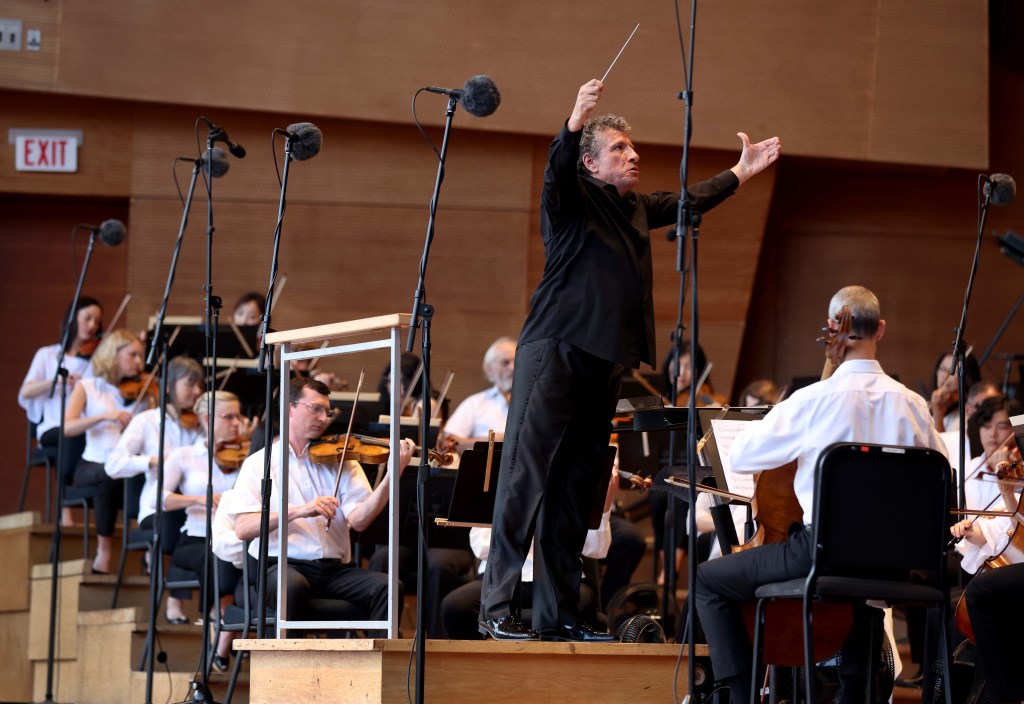After a mostly underwhelming two weeks led by former Seattle Symphony baton Ludovic Morlot, on Wednesday the Grant Park Music Festival put up a second contender to succeed outgoing conductor Carlos Kalmar: the Costa Rica-born, Nashville-based Giancarlo Guerrero, who last appeared at the festival in 2014.
Call him Maestro 180. Not only was Guerrero’s leadership night and day from his last local appearance — a spotty April showing with the Chicago Symphony and Jazz at Lincoln Center Orchestra — but his curatorial and interpretive creativity set a high bar for the director search going forward.
Rather than dive into an evening-length program, Guerrero put forward a short yet dense exploration of two pieces: Joan Tower’s “1920/2019” and Dmitri Shostakovich’s Symphony No. 5. Musically and politically, those works — big-boned and anxious — are of a feather, despite being created in radically different contexts.
In 2020, the New York Philharmonic invited Tower and 18 other women composers to write new works pegged to the centenary of the 19th Amendment. The “2019” in Tower’s title links the amendment to the latter-day #MeToo reckoning, still in full swing when she began the piece. After the piece’s New York premiere, Guerrero programmed “1920/2019” in his own Nashville Symphony concerts commemorating Tennessee’s deciding vote in the 19th Amendment’s ratification.
Intentionally or not, the piece parallels the herky-jerky, “what century are we living in, again?” trajectory of women’s rights as a whole. Themes cycle back, flirting with repetitiveness; the piece careens and crawls, as though its forward momentum is repeatedly foiled. The exception to the rule is an outré percussion interlude, played ferociously by Joel Cohen, Doug Waddell and timpanist Daniel Karas.
Another version of “1920/2019” might have ended there. Instead, the piece dissipates after repeating a much-earlier section for cello and violin solo, played elegantly by principals Walter Haman and Jeremy Black. The audience is left with something that sounds an awful lot like what they’ve already experienced — pretty depressing, if you extend the metaphor.
Guerrero was a most thoughtful steward of Tower’s musical narrative. He let the piece’s tension build gradually, slow parts stretching like taffy. Later, a cleanly etched dotted theme seemed to hint at the Shostakovich to come.
Working in Stalin’s Soviet Union at the time he wrote his Symphony No. 5, Shostakovich could hardly imagine being invited by a major orchestra to opine on politics, as Tower had. In trying to toe the precarious line between state approval and genuine artistic expression, Shostakovich produced what is now embraced — perhaps hagiographically so — as one of the deftest musical protests ever written, all without uttering a word.
Kalmar’s casual audience remarks have made frequent public speaking part of the expectations for a Grant Park head. Guerrero provided context for both pieces in comments that mirrored his interpretation of the symphony: emphatic, practiced and assertive.
Every bar was a decision, and even eyebrow-raising ones paid off. Guerrero had the Grant Parkers play the first movement’s pulsing quarter-eighth note motif legato (smooth and lyrical). Even the snare drum takes up that articulation when it appears in the explosion of the first-movement march; principal percussionist Josh Jones played with sinister intensity there and at symphony’s very end.

This is serious music — deathly so, but not exclusively so. Guerrero led a second movement of teasing levity, sometimes dropping his arms and at one point striding towards the violins with a silly, jaunty high-step. Black’s exquisite violin solo followed his lead, embodying charm and finesse rather than the fiddly gruffness one sometimes hears.
Guerrero’s default mode is intense, and some of the third movement’s climaxes were wrung out most forcefully — maybe too forcefully. But by way of pacing, the fragile, suspended, solitary Largo was patient without losing momentum. Likewise, at a time when conductors du jour love ratcheting up the last movement’s tempos, it was a relief to hear Guerrero make a case for Shostakovich’s own markings, the piece beginning and ending with grandiose breadth. Even a festival orchestra playing short of its usual standard — with intonation splats in the horns, violins and cellos — didn’t blot this Shostakovich’s brilliance.

Allotted two concert programs next to Morlot and Eric Jacobsen’s three, Guerrero has less time to make an impression than those other candidates. For a program this short to linger so long? Something tells me Guerrero will have no problem leaving his mark.
“Beethoven Emperor Concerto,” 6:30 p.m. July 12 and 7:30 p.m. July 13, Jay Pritzker Pavilion at Millennium Park, 205 E. Randolph St., free, grantparkmusicfestival.com. (Pianist Terrence Wilson steps in for Stewart Goodyear.)

